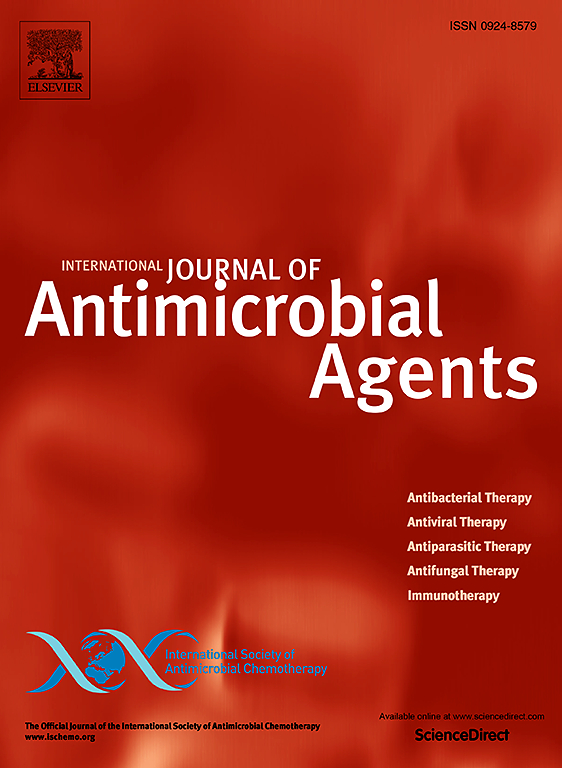整合子是β -内酰胺酶编码基因传播的关键角色。
IF 4.9
2区 医学
Q1 INFECTIOUS DISEASES
International Journal of Antimicrobial Agents
Pub Date : 2024-12-20
DOI:10.1016/j.ijantimicag.2024.107421
引用次数: 0
摘要
整合子介导基因盒(GCs)的获取和表达。β -内酰胺酶(BLs)的产生是β -内酰胺耐药最相关的机制。为了探讨整合子在BL基因传播中的作用,我们从INTEGRALL数据库中检索了序列和元数据,并进行了文献综述。在37个细菌属中检测到携带≥1个bl编码基因的整合子(主要为1类)(n = 1,981),编码的bl来自18个科。我们鉴定了159个bl编码基因盒(BLGCs),代表了所有Ambler类,其中最普遍的是blaxa -, blaVIM-和blaimp -携带整合子。blaGES、blaBEL和大多数金属bls仅与整合子相关。ISCR1在复杂整合子(n = 234)中捕获了来自13个家族的BL基因,即blaNDM、blaCTX-M和blaTEM。经常共同检测到的gc编码对所有主要类别抗生素的耐药性,即氨基糖苷类、酚类和甲氧苄啶。大多数BLGCs编码对碳青霉烯类耐药(n = 90),铜绿假单胞菌是最常见的宿主。大多数携带bla的整合子来自临床环境,而废水是最丰富的环境隔间。BLs和整合子的频繁关联表明在β -内酰胺耐药性传播中起着重要作用。考虑到整合子是(i)低成本结构,通常与其他可移动元件相关,以及(ii)通常携带多个GCs(根据环境刺激可互换),在进行监测和流行病学研究时,应始终将BL基因与整合子的关联视为β -内酰胺耐药性传播的风险因素。进一步的研究监测整合子的流行和多样性,特别是在非临床环境中,将更全面地了解整合子相关的β -内酰胺耐药传播。本文章由计算机程序翻译,如有差异,请以英文原文为准。

Integrons are key players in the spread of beta-lactamase-encoding genes
Integrons mediate the acquisition and expression of gene cassettes (GCs). The production of beta-lactamases (BLs) is the most relevant mechanism of beta-lactams resistance. To explore the role of integrons in BL genes dissemination, sequences and metadata were retrieved from the INTEGRALL database and a literature review performed. Integrons (mostly class 1) carrying ≥1 BL-encoding genes (n = 1981) were detected in 37 bacterial genera and encoded BLs from 18 families. A total of 159 BL-encoding gene cassettes (BLGCs) were identified, representing all Ambler classes, with blaOXA-, blaVIM- and blaIMP-carrying integrons the most prevalent. blaGES, blaBEL and most metallo-BLs were exclusively associated with integrons. BL genes from 13 families were identified as genes captured by ISCR1 in complex integrons (n = 234), namely blaNDM, blaCTX-M and blaTEM. Frequently co-detected GCs encoded resistance to all major classes of antibiotics, namely aminoglycosides, phenicols and trimethoprim. Most BLGCs encoded resistance to carbapenems (n = 90) and Pseudomonas aeruginosa was the most frequent host. Most bla-carrying integrons were from clinical contexts and wastewater was the richest environmental compartment.
The frequent association of BLs and integrons indicates a significant role in dissemination of beta-lactams resistance. Considering that integrons are (i) low-cost structures often associated with other mobile elements, and (ii) often carry multiple GCs (interchangeable according to environmental stimuli), the association of BL genes with integrons should always be considered a risk factor for the spread of beta-lactam resistance when performing surveillance and epidemiological studies. Further studies monitoring prevalence and diversity of integrons, particularly across non-clinical environments, will draw a more comprehensive picture of integron-associated dissemination of beta-lactams resistance.
求助全文
通过发布文献求助,成功后即可免费获取论文全文。
去求助
来源期刊
CiteScore
21.60
自引率
0.90%
发文量
176
审稿时长
36 days
期刊介绍:
The International Journal of Antimicrobial Agents is a peer-reviewed publication offering comprehensive and current reference information on the physical, pharmacological, in vitro, and clinical properties of individual antimicrobial agents, covering antiviral, antiparasitic, antibacterial, and antifungal agents. The journal not only communicates new trends and developments through authoritative review articles but also addresses the critical issue of antimicrobial resistance, both in hospital and community settings. Published content includes solicited reviews by leading experts and high-quality original research papers in the specified fields.

 求助内容:
求助内容: 应助结果提醒方式:
应助结果提醒方式:


